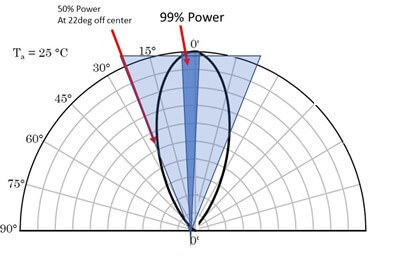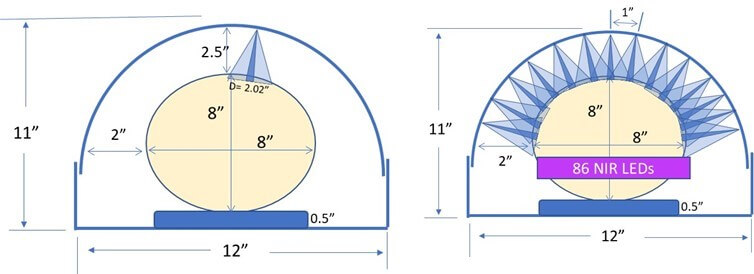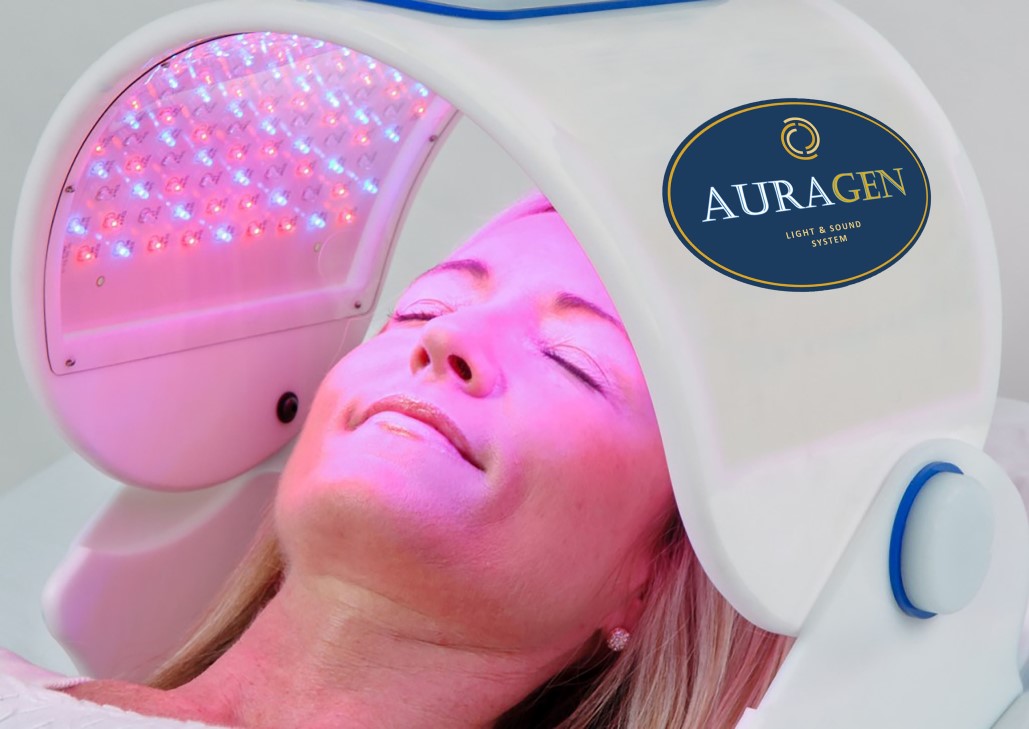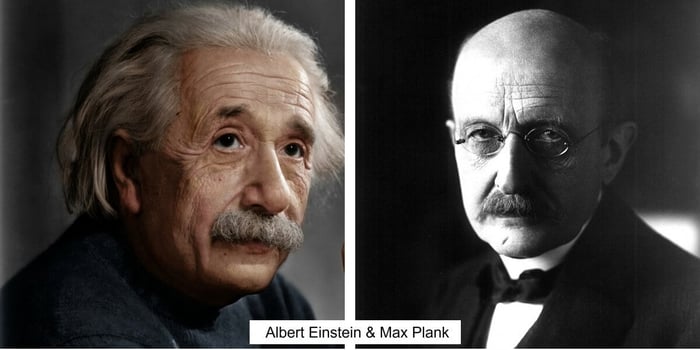There are more and more scientific discoveries being made on the beneficial effects of light therapy on the body and brain. A key element associated with the power of light is the photon. Thus, in order to understand the science of light therapy, we need to grasp some basic physics about the photon. This can help you appreciate the power of light therapy and will also provide you with an understanding of how a light therapy unit can best deliver photons to maximize the benefit to the user.
The photon was identified by Einstein who built on the work of Max Planck, who was the first person to propose that discrete energy parts of equal size exist in electromagnetic waves. What was discovered is that every electromagnetic wave, such as Red light or Blue light, consists of photons (equal size units of light energy) and each photon in a specific wavelength has the same amount of energy. A photon is massless, travels at the speed of light, so it has no knowledge of time, and retains its energy as it travels unimageable distances through light years of space. What is also surprising is that the amount of energy in a photon is very easy to calculate. It is the speed of light divided by the wavelength of the photon times a constant number/fixed value. The constant number value is known as Planck’s constant. Planck's and Einstein's groundbreaking work laid the foundation of light therapy science.
Why is it useful to know what the energy level of a photon is? Well, this is because it defines the amount of energy a photon has when it impacts an object such as your body or skin. The energy of each photon is the same for a given frequency, and the higher the frequency, the more energy a photon possesses. Thus, because we know how to calculate the energy of the photon, we can understand why a higher frequency photon has more energy to penetrate deeper than a lower frequency photon.
The penetration depth of Blue, Red, and NIR light on the body has been measured many times by scientists. However, the penetration depth of a photon is independent of the number of photons being delivered. This means the intensity of the light has no meaning on the penetration depth of the photon since the photon energy is not defined by the number of photons being emitted, but by only its frequency (energy = speed of light / wavelength x Planck’s constant). Thus, even though there may be millions of red light photons, all these photons with that energy will only go to a specific depth within the body, because the energy of each individual photon is what defines it’s penetration depth. So, this is why the penetration depth does not change based on the quantity of photons being emitted. What does changes is the ability of the detection instrument to detect the photons, which becomes easier when more photons are present in a given area.
An example of a photon penetration depth capability that we are all familiar with is the example of photons associated with X-Rays. X-rays travel easily through skin and bone, and thus can be used to make x-ray photographs of the inside of our body. The total power of the X-ray machine does not define the penetration depth of the x-ray, but the power does define how many x-rays go through your body. The more x-ray photons that we are exposed to can have a damaging effect to your health. Today better
X-ray machines are being used with better detectors that are capable of detecting fewer amounts of
X-ray photons. This allows lower power X-ray machines to be used by doctors, since the photon energy and not the total number of X-Rays is what defines the penetration depth of the photon through our body. Those of us who are older remember that our dentist was required to put a lead blanket over our body because the older X-Ray machines had to emit lots of X-Ray photons for the detector to work but with the newer dental X-ray machines that is no longer required.
To help understand why there is a difference between photon energy and the intensity of a source we provide the following description of how photon radiant intensity changes as photons travel through space. The total number of photons in a given area defines the intensity of that source. As photons are traveling through space, they start to separate from each other as they travel father and farther away from the source. The dispersion of these photons means that they become harder to detect because there are fewer of them within a given area. But the energy of each of these photons as they get farther apart does not change and you can refocus these photons into a tighter grouping again so they are more detectable.
The photons can be regrouped by utilizing a large area collector that refocuses the photons from the larger area into a smaller area. An example of this in the real world can be seen with a magnifying glass. By using a magnifying glass, we can take the energy of many photons that are distributed over a large area and focus them down into a tight beam that generates so much light in single area that the heat from all that light in one small area can start a fire.
Why is this insight important to understand? Well, there have been a few papers drafted about various light therapy units discussing the analysis of their Light Emitting Diodes (LEDs) and the penetration depth of the LED light frequency. The papers state that brighter or more powerful wattage LEDs are required to reach a certain penetration depth within the body. As we now understand, the penetration depth of a photon is not defined by the power of the wattage of the LED. The penetration depth is only defined by the frequency of the photon or light source. If the LED light beam is such that 99% of the radiant intensity energy hits the surface of the skin, then 99% all of those photons from the source penetrate the body to the same depth.
Some of those papers also say that the IR LED radiance was not detectable after traveling through only a few cm of air. So again, we can go back to physics and understand that photons do not loose energy in space as they travel, however atmospheres such as air can impact some photons. When light travels through our atmosphere, the primary element impacting electromagnetic waves or photons are the molecules in the air which can have two effects. The first effect is that the air molecules can be stimulated and excited to vibrate by the electromagnetic wave and the other effect is that air molecules can cause the light or electrical wave to be scattered or refracted like a light prism.
Air is made up mostly of nitrogen, dioxide (02), and water molecules and the resonate frequency of these molecules is not close to Red, Blue, or NIR light. Thus, Red, Blue, and NIR frequencies do not lose energy as they pass through the air. An example of the second effect, light scattering , we see every day with the sky having a blue color. This is due to the scattering of Blue light frequency as the light hits particles in the air. This scattering effect does not apply to most LED units since the distance of the photo traveling through the air is just a few inches. We also note that the scattering effect does not consume energy, it is just scatters the light in a different directions.
So given this discussion on the science of light therapy, what are the important factors we should consider in relation to assessing a light therapy unit?
1) What is the wavelength / frequency of the light emitted from the LED, because that defines the penetration depth of the photon.
2) What is the radiant intensity (not the wattage) of that LED, since that defines how many photons are being emitted by the LED. Knowing just the wattage of the LED is not helpful, because the wattage envelopes other factors such as the amount of heat being radiated and not just the amount of light being emitted.
3) The beam width (radiant intensity changes as a function of angle change from the center of the source). You want a focused beam that directs most of its energy (>98%) toward the intended surface within a tight cone and not an omni directional source that spreads the light out like a beacon.
4) The total number of LEDs and the total surface area being radiated toward the body, since that coupled with the beam width and radiant intensity defines the total number of photons penetrating the body and how much of the body area is being treated. Having an intense source in just one location means lots of photons are focused on just one area and that they are not penetrating other key regions of the body.
AURGEN Provides a High Value Near-Infrared LED Therapy
The Auragen System was developed to maximize delivery and therefore, benefits of light, based on the science of light therapy.
Near-Infrared Photon Body Penetration: The wavelength of Auragen’s NIR LEDs is 880 nm which penetrates close to and into the bone to reach the brain, soft tissue, and joints.
NIR Radiant Intensity and Spatial Distribution: Auragen’s NIR LED delivers >99% of the radiant intensity within a five degree from center cone and > 50% of the radiant energy with a 22 degree from center cone, to provide a focused beam to your body parts under our dome. The LEDs are design to provide a radiant intensity of 15 mW/sr, and just for reference, the NIR power dissipation or wattage is 85 mW

Total Area exposed With Auragen’s NIR LED Treatment: Auragen’s LEDs are <2.5 inches away from the head of a user. As discussed, greater than 99% of the LED intensity is delivered within a five degree from center cone so that at 2.5” away, the total surface area treated by a single LED at 99% intensity is 0.15 in2. The resulting LED radiant intensity at 2.5” away under each LED, within the 99% intensity area is >0.36 mW. At 2” it is > 0.56 mW, due to the smaller cone shaped surface area at 2” away. Auragen utilizes 86 NIR LED lights, so the total treatment surface area at the 99% LED intensity level by Auragen is >13 in2., and the total radiant intensity on the head from all the NIR LEDs under the 99% cone is >30.96 mW.
Furthermore, the LEDs dissipate 50% of their energy within a 22 degree from center cone and the resulting surface area under a single LED that has greater than 50% radiant energy at 2.5” away is 3.2 in2. Thus, the overlapping NIR LEDs radiant intensity beams, cover all the exposed areas of the head.

AURGEN Also Provides Red and Blue-Turquoise LED Therapy
In addition to the 86 NIR LEDs, Auragen delivers light therapy with 108 Blue-Turquoise LEDs at 465nm and 134 Red LEDs at 640nm, totaling 328 LEDs. The Blue-Turquoise and the Red LEDs have very similar radiant intensity beam width profiles as the NIR LED and the luminous intensities are >3690 MCD (millicandela) and >2390 MCD respectfully.
Its important to remember, that the penetration of photons in light therapy is just the beginning, as the human body is designed to disperse the absorbed radiant energy.
Based on what you just learned about light therapy science compare the power, features, and benefits of Auragen to other light therapy devices:
COMPARE THE VALUE


